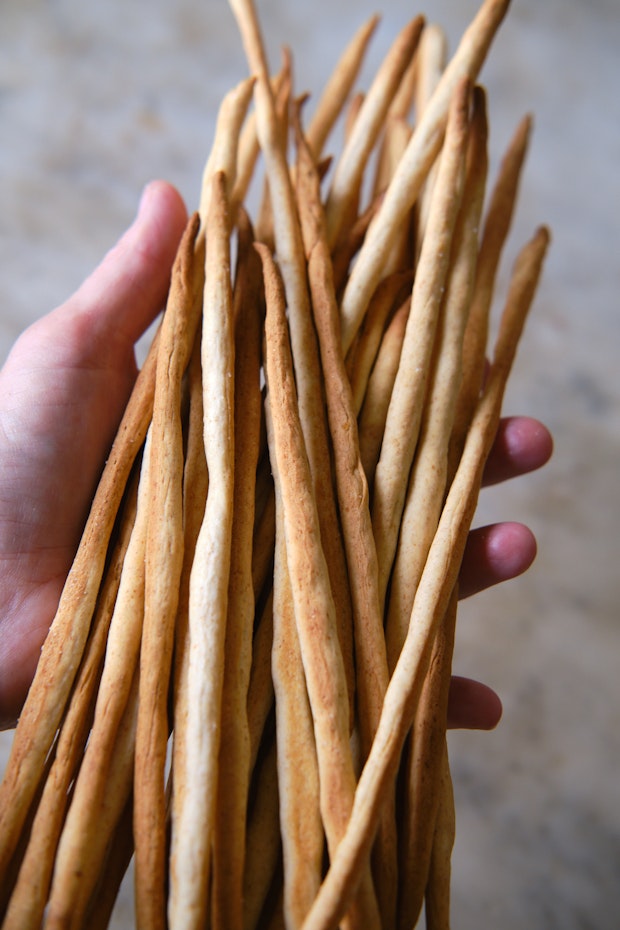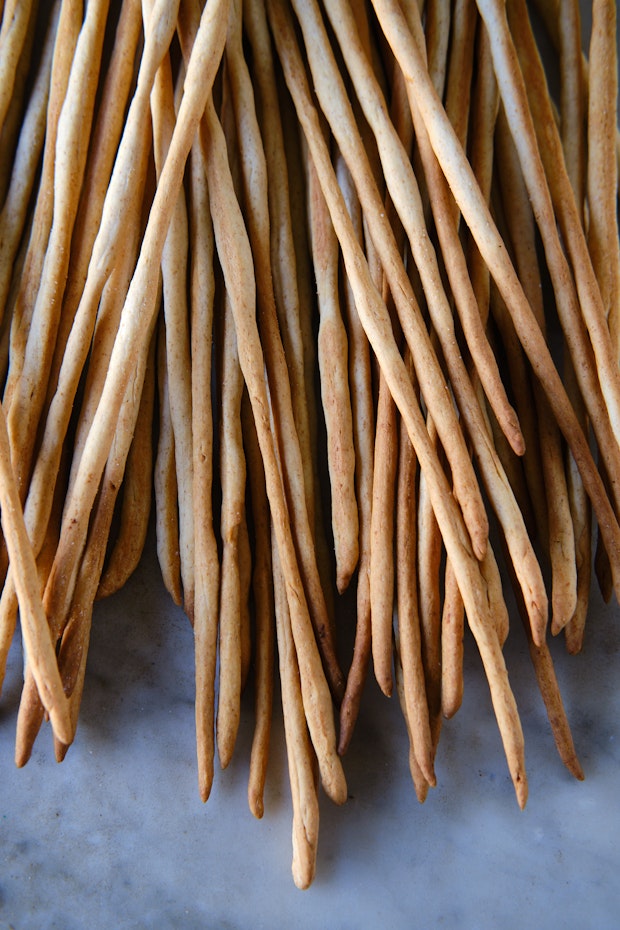Grissini bring charm and drama wherever they appear. The beloved thin and crispy Italian breadsticks are great alongside a cheese board, welcome crumbled over soup, and are forever kid-friendly. At their best, they maintain snap and crunch, radiate imperfect handmade charm, and can (arguably) rival flowers when arranged in “bouquets” running the length of a table. They’re simple to make, and turning the task into an all-hands group activity makes quick work of the shaping.

Grissini: The Inspiration
I started baking grissini at home many years ago inspired by a nearby restaurant. We would regularly walk from our house to Pizzeria Delfina in San Francisco’s Mission District. The first thing that would be placed on your table, after being seated, was a tall glass filled with pencil-thin grissini (breadsticks). Next would come a tiny plate with a trio of chile flakes, Parmesan, and dried oregano for topping your pizza. We’d snack on grissini, sip on good wine, and chat while waiting on the main event. I loved having them at the start of a meal. They’re a labor of love to make, and I delight in the way each one is slightly different and reflects the hands (and whims!) of the baker.
How To Make Grissini
If you can make pizza dough, you can make grissini. I use much of the same technique to make the dough here as I do with my go-to pizza dough recipe. You’ll mix the dough by hand, use instant yeast (so there’s no need to worry about proofing). After mixing, wait for a bit of a rise, chill, shape and then bake. I’m willing to bet you have most of the ingredients on hand.
Above you see the butter melting in warm milk. And below, the dough ready to be refrigerated for a bit.
A Few Tips
I mention this below, but these are the keys to great grissini.
- Thin not thick: Roll your dough pencil thin. I include specifics below, but aiming for the thickness of a pencil is the goal for snappy sticks. These are 12 inches long, shaped from a 7 gram piece of dough. Mark out your ideal length with tape (see below) for easy uniformity.

- No blond breadsticks: Bake the breadsticks until golden all over. This is important for snap and crunch.
- When shaping, you’re the boss: You will likely need to be a bit assertive when rolling out the dough. Use your hands and have fun. If the dough is resistant, springing back, just set that piece aside while you roll others and come back to it after a few minutes. It will relax.

Grissini Variations
The recipe below is what I consider a base recipe. You can add any number of herbs, spices, or creative ingredients to it if you like.
- Vegan Grissini: Follow the recipe as written, opting for water as the liquid and olive oil as the fat.
- Spicy Mustard Grissini: Katy, owner of Monsieur Marcel in Los Angeles recently turned me on to a beautiful spicy mustard seed oil. I swapped out some of the olive oil in the recipe below and replaced it with this (about half) for a mustard-kissed version.
- Herbed Grissini: For herbed grissini, use dried herbs. Start with a tablespoon or two of chopped rosemary. You can also use blends like “Italian seasoning” or Herbes de Provence.
- Sesame Grissini: After arranging breadsticks on the baking sheet, spray with a bit of olive oil and sprinkle generously with sesame seeds. You can leave them as is, or give a bit of a twist.
- Everything Bagel Grissini: Similar to the sesame version above, but use everything bagel seasoning.
- Parmesan Grissini: Add 1/2 cup of freshly grated Parmesan to your dry ingredients before mixing. Experiment with other dried cheeses.

More Italian Recipes
Continue reading Grissini (Italian Breadsticks) on 101 Cookbooks





